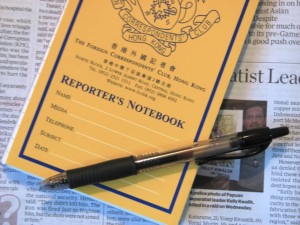I want reporters to make their notebooks public, because I want news organizations and audiences alike to enjoy the fruits of transparency that the web is bringing to us. There are at least two problems with this idea: these notes are indecipherable scribbles on paper, and reporters won’t want to do it. Recording audio instead of ink and using machine transcription will help with the first problem, while the cultural shifts brought by the slow but inevitable rise of lifelogging will help with the second.
The traditional “voice of god” news writing style just doesn’t cut it on the web, where Wikipedia has made us expect hyperlinked footnotes to every statement and bloggers happily admit their uncertainties. I’m hardly alone in calling for professional journalists to be more upfront about the sausage-making that is news production.
Not only might this renew the public’s battered trust of pro media, but showing your work lets other people build on it. Bloggers and Tweeters don’t wait until they have the full story to publish a new fact or post an interesting interview, allowing that information to be used immediately by someone else. As I have argued extensively, working journalists need to get into the habit of collaborating with their communities.
It’s quite possible that everyone wins when professional journalists show their work.
First problem: the scribbles. It’s really hard to write fast when you’re taking down a quote. The result is chicken scratchings and personal shorthands. Each reporter’s notebook is written in its own code. Even if anyone could read the writing, they’d find only a battered mess of sentence fragments and unidentified quotes. Besides, the notebook is on paper. We could ask reporters to come back to the newsroom after each assignment and scan their notes, but that would be useless.
Reporters might consider recording their interviews instead, as they often do already, and posting those recordings online. Want to know more than the article says? Just watch the video or listen to the tape. The Nieman Journalism Lab already makes a habit of this.
But transcribing recordings is a huge time-sucking pain in the ass, and AV isn’t searchable so there’s no quick way for either the reporter or the audience to find that favorite quote. Enter machine transcription, automated speech-to-text systems that produce a transcript of any conversation. This sort of technology is still in its infancy, and it has accuracy problems — but it’s already used by Google Voice to convert voicemail to email, by YouTube to make videos of political speeches searchable, and in Adobe Premiere for semi-automated tape logging.
Rather than the notepad, I envision the journalistic tool of the future to be a Blackberry or iPhone with real-time speech-to-text software running on it. And I want a “tag this” button on the phone, which I will push to mark the time whenever someone says something interesting. Immediately after the interview, I might review the transcripts and tweet any particularly interesting points from my mobile device. Back at the newsroom, I would cut and paste quotes from marked times, then upload the article and post the entire recording, including its transcript. Done, and anyone who wants to know more than my 200 word summary is free to roll the tape to do their own sleuthing.
Of course, this means that everything the reporter says will be public. This will be a change. It won’t always be appropriate, as with off-the-record chats or embargoed material. But most of all, I think it’s going to take getting used to the idea that our lives and our work are going to be a lot more public than they were.
On Tuesday I worked with a colleague to interview an Indonesian street performer. The recording on my iPhone also caught us in a brief, er, discussion about who was going to type up the transcription. I would be hesitant to put the recording online because of that, and because it reveals all the snarky comments, translation confusions, possible inaccuracies and in short, the entire messiness of the journalistic process. Traditional journalistic style is clean, well ordered, literally black and white. The real world isn’t like that, and showing our work is going to destroy some cherished myths.
But then, entire civilizations used to think that the King was descended from the gods. Some myths are worth losing. And we are losing them: LiveJournal, Facebook etc. are giving us new notions of privacy and with them, an outpouring of strikingly honest accounts of what it is to be human. Meanwhile, we’re going to start recording much more of our lives, and with much less effort. Imagine an audio recording of every moment of your life, with good search capability. Such a system would be a form of perfect memory. Life-logging is going to happen; the technology is already here, so I’d guess that teenagers are going to be growing up with it within a decade.
Recordings of candid moments will then become commonplace, and if we’re lucky, we’ll all become more forgiving as we gain a better understanding of human fallibility.
In this context, it won’t seem so scary for a journalist to post the unedited records of their encounters with reality. In fact, it’s going to become necessary. Everyone else will be doing it.

One thought on “Lifelogging + Machine Transcription = Public Reporters’ Notebooks”